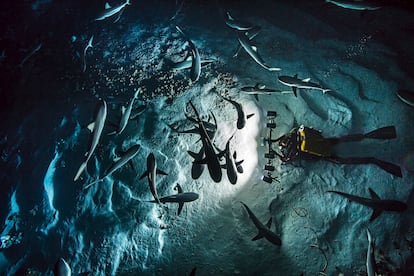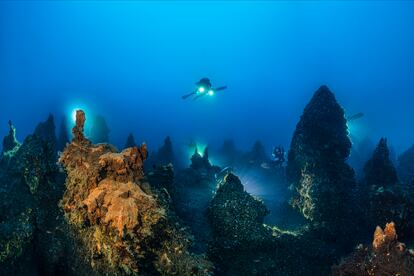Laurent Ballesta, raconteur of the oceans
The marine biologist and renowned nature photographer is also a great storyteller

Let me introduce you to a man who regularly risks life and limb as an extreme explorer, an uncommon job in 2023. His name is Laurent Ballesta, and he was born in 1974 in Montpellier, France. What sets him apart from you and me is his vast experience exploring the depths of the ocean. He has immersed himself for hours, days, weeks to experience a completely different world beneath the surface. Imagine swimming among 700 gray sharks, their movements synchronized with fierce determination as they hunt their prey. Picture capturing the intense moment of a small fish narrowly escaping the jaws of its predator. Envision the grandeur of an iceberg, not just the tip, but its entire majestic presence. And imagine coming face to face with a living fossil, a creature once believed to be extinct. All these extraordinary encounters have taught Ballesta about the violence of the depths, with all its cruelty and beauty. He embodies multiple roles – diver, marine biologist and renowned nature photographer. Beyond capturing breathtaking visuals, he is also a captivating storyteller. But he has a strict rule about revealing his plans beforehand. There is no braggadocio or breathless announcements of his adventures to be found on social media. “People tend to talk a lot before going on expeditions, but not so much after. Probably because they haven’t discovered anything new,” he told El PAÍS from Andromède Océanologie, his operations center at Carnon Beach near Montpellier.
The life of an extreme explorer is unusual. Ballesta spends countless hours persuading people to place their trust in projects that seem to lack direction. Projects like, “Let’s explore the Antarctic seas” or “Let’s try and find a coelacanth. It may not even exist and the last people who went looking died.” He has the gift of gab and the fortunate backing of renowned watchmaker Blancpain, a sponsor of his expeditions since 2012. His endeavors also receive funding from the French Ministry of the Environment.

Ballesta also spends a lot of time convincing his diver friends to accompany him on fantastic expeditions that can often be uncomfortable and dangerous. He says diver selection is crucial, given that they will be living together in extreme conditions. This includes crowding into a confining, 54-square-foot (five-square-meter) station where they must breathe a mixture of oxygen and helium and eat sizable quantities of pasta. “Being friends isn’t enough. You have to know that you can live together in a small space. And they have to be even-tempered because I’m not so easy to live with either.”
His challenges are always extreme. In 2007, he took a photo at a depth of 190 meters (623 feet) near Nice (France), the deepest photo ever taken by a diver outside a submersible. In 2010, after years of research, he photographed and filmed the coelacanth in South African waters. In 2019, he spent 28 days living underwater with three other divers in the Mediterranean, between Monaco and Marseille. In 2021, he spent another 20 days at a depth of 120 meters (393 feet) in Cap Corse, Corsica, studying coral ring formations.
Ballesta says he feels like a new man after those expeditions (and the several days of decompression that follow). That’s when he starts telling stories. By the age of 13, he was already telling tall tales about his diving experiences. “I could talk for two hours about 10 minutes underwater,” he said. He used to lament that his parents weren’t explorers. “We’re not a typical Cousteau family,” he would say. They were beach lovers who preferred to stay above the surface, sunbathing and reading on a lounge chair. Ballesta liked doing things on dry land as a child, like playing soccer with his cousins. But what he really loved were the Jacques Cousteau documentaries he could watch for hours. When he joined the diving club before turning 14 (not allowed), he made a remarkable discovery – Cousteau wasn’t just a TV character, but a real person. Enthralled by the hero of the movies he loved, Ballesta wanted to be like Cousteau. Who did Cousteau turn to for answers? Marine biologists! Ballesta decided to become one and also delved into the art of photography. Yet, whenever he told stories of his adventures, like coming face-to-face with a six-meter (20-foot) shark, people would give him a friendly pat on the back and say, “Sure, sure.”



The first time Ballesta heard about the coelacanth was in 2001. A year earlier, South African diver Peter Timm had spotted one at a depth of 120 meters (393 feet), but lost his best friend in the pursuit. The coelacanth is a dark creature that usually lives at a depth of 700 meters (3,300 feet). It can grow up to two meters (6.5 feet) long and weigh up to 90 kilos (200 pounds). It’s believed to be a missing link in the evolution from vertebrate fish to four-legged terrestrial creatures. Ballesta became obsessed with photographing one up close in its lair. “The difficult part is getting to the coelacanth’s world. Once you’re in the right place, it hardly moves and is very photogenic,” said Ballesta. Peter Timm, who passed away in 2014, took him to the spot where he had found one, and Ballesta’s team became the first to film the living fossil. He says it was his most stressful expedition, and two of his fellow divers decided they would never do that again.
When Ballesta makes deep dives, he always takes several electronic devices with him. But his favorite tool is a mechanical dive watch from Blancpain’s Fifty Fathoms collection. Created in 1953, it was the first modern dive watch and is still made today, 70 years later. “I can’t even imagine how divers used to navigate without these watches. In case the electronics fail, the watch is the perfect backup.”
When I ask about the retirement age of divers, Ballesta gets serious. “Officially, you should have two annual medical check-ups after the age of 40. I haven’t done that yet. I exercise daily, eat well, don’t smoke, and take care of myself as much as I can. I believe you should quit diving when you’ve lost your curiosity. Mine is still very high and outweighs all the pain.” He’s talking about his numerous back injuries and the two fingers that have been numb since his expedition to Antarctica eight years ago. “Diving hurts more now than it did 10 years ago, but my curiosity still keeps me going.”
Sign up for our weekly newsletter to get more English-language news coverage from EL PAÍS USA Edition
Tu suscripción se está usando en otro dispositivo
¿Quieres añadir otro usuario a tu suscripción?
Si continúas leyendo en este dispositivo, no se podrá leer en el otro.
FlechaTu suscripción se está usando en otro dispositivo y solo puedes acceder a EL PAÍS desde un dispositivo a la vez.
Si quieres compartir tu cuenta, cambia tu suscripción a la modalidad Premium, así podrás añadir otro usuario. Cada uno accederá con su propia cuenta de email, lo que os permitirá personalizar vuestra experiencia en EL PAÍS.
¿Tienes una suscripción de empresa? Accede aquí para contratar más cuentas.
En el caso de no saber quién está usando tu cuenta, te recomendamos cambiar tu contraseña aquí.
Si decides continuar compartiendo tu cuenta, este mensaje se mostrará en tu dispositivo y en el de la otra persona que está usando tu cuenta de forma indefinida, afectando a tu experiencia de lectura. Puedes consultar aquí los términos y condiciones de la suscripción digital.
More information
Últimas noticias
Most viewed
- Sinaloa Cartel war is taking its toll on Los Chapitos
- Oona Chaplin: ‘I told James Cameron that I was living in a treehouse and starting a permaculture project with a friend’
- Reinhard Genzel, Nobel laureate in physics: ‘One-minute videos will never give you the truth’
- Why the price of coffee has skyrocketed: from Brazilian plantations to specialty coffee houses
- Silver prices are going crazy: This is what’s fueling the rally









































